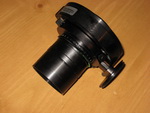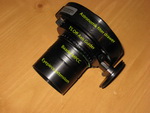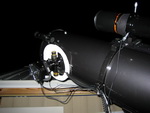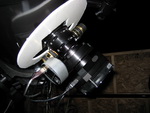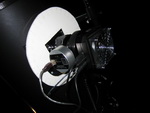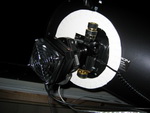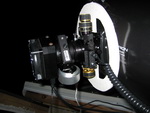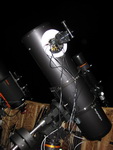Imaging with Orion 10" Newtonian
My Orion 10" is used exclusively for imaging. I had to modify it a bit in order to optimize it for this purpose - I changed the focuser to JMI EV-1 as described on O10 main page. An image done with an APS-C size sensor will show coma without an corrector. There are two correctors currently available - TeleVue Paracorr and Baader MPCC. I chose MPCC because it is much smaller and lighter. Baader MPCC must be placed exactly 55mm from the sensor, which in turn restricts the way imaging train is assembled. It is not a big problem when using a dedicated CCD imager like QHY8 with a backfocus of only 15mm (leaving 35mm for other equipment), but it may be a big restriction when used with a DSLR (Canon 40D in my case). A typical DSLR has 55mm backfocus from the front of lens mounting to the sensor, which means Baader MPCC must be installed just in the front of the DSLR camera.
I started imaging with O10 autoguiding through piggybacked C80ED refractor and it worked fine. I use O10 setup for both regular color imaging with one-shot color sensor (OSC) cameras as well as for narrowband imaging, and in the latter case subexposure time is much longer. Unfortunately with exposures longer than 5 minutes some flexure shows up in a form of elongated stars, and despite my best efforts I was not able to get rid of it. Therefore I had to switch to an off-axis guider to extend my exposure times. But as stated above I have to place MPCC 55mm away from the sensor, what immediately eliminated Canon 40D as camera as well as most off-axis guiders available on the market that were simply too thick. Fortunately I found a very low profile off-axis guider from a German company Teleskop Service called TS Off-Axis Guider (TSOAG), available in the US from Teton Telescopes. It is only 9mm thick and can be easily configured with appropriate adapters to accept MPCC on the one side and Astronomik filter drawer on the other side, as shown below.
My current setup for imaging with Orion 10" Newtonian consists of Baader MPCC corrector, TS Off-Axis Guider, Astronomik filter drawer and self-modified Canon T2i (previously QHY8 camera from CCD-Labs). I like the results it produces, the examples are NGC7023, M8 (Canon 40D), NGC6888 (narrowband, QHY8), M106 (QHY8) and M81/M82 (T2i). Field of view for QHY8 sensor is 68'x45' which fits nicely between C14 Hyperstar (113'x75') and C14 at f7 (30'x20'). Also, thanks to relatively low focal ratio it is easy to find suitable guiding star in the off-axis guider field of view.
Current Orion 10" imaging setup consists of Baader MPCC, TS Off-Axis Guider, Orion StarShoot Autoguider, Astronomik filter drawer and self-modified Canon T2i camera. Off-axis guiding is relatively easy with Orion 10" at f4.7 since guider camera field of view is quite big and it is usually easy to find a guiding star. Same as with C14 I plan my imaging sessions in advance choosing the best guiding star, I have a graduated ring made of foam core poster board attached to the OTA around the focuser to simplify setting a guider orientation.
It is important to keep Newtonian well collimated for imaging. I use collimating laser (I have two, one 1.25" and one 2", see equipment), and it is only needed to do it when OTA was moved or when average temperature changes a lot, usually in the spring.
